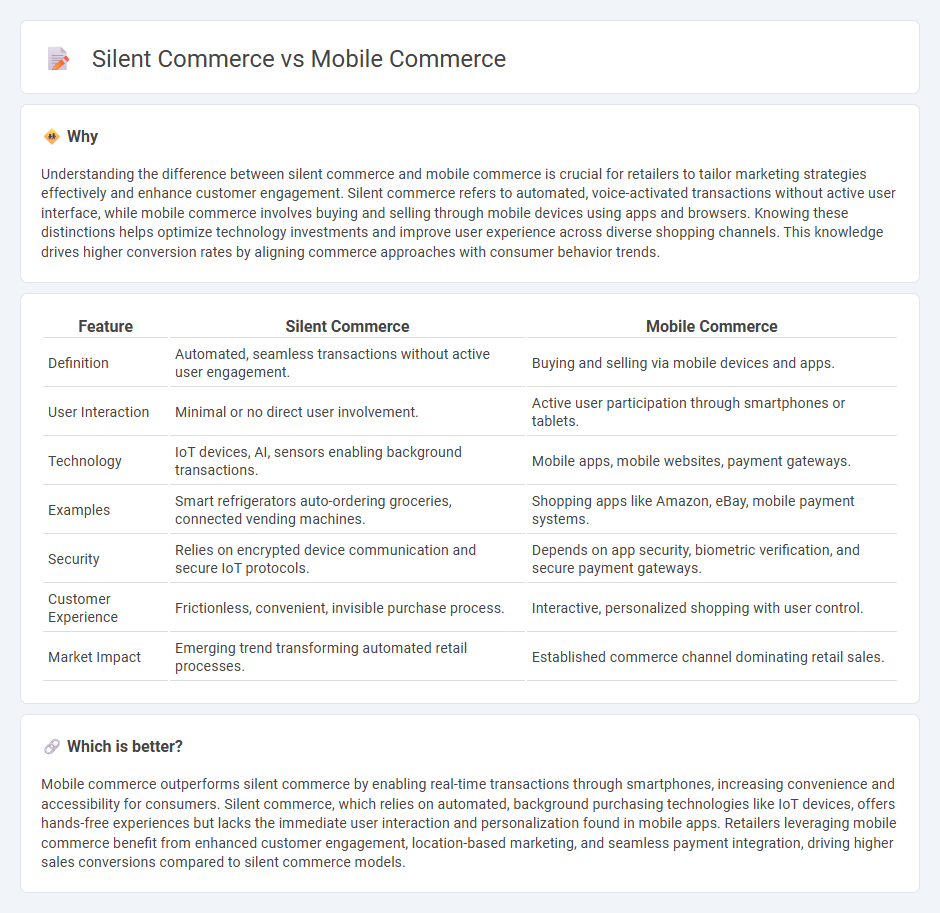
Silent commerce integrates transactions seamlessly into everyday activities through voice assistants and IoT devices, enhancing convenience without interrupting user experience. Mobile commerce leverages smartphones and tablets, enabling consumers to shop anytime and anywhere with apps and mobile-friendly websites. Discover how these evolving retail technologies reshape consumer behavior and drive sales growth.
Why it is important
Understanding the difference between silent commerce and mobile commerce is crucial for retailers to tailor marketing strategies effectively and enhance customer engagement. Silent commerce refers to automated, voice-activated transactions without active user interface, while mobile commerce involves buying and selling through mobile devices using apps and browsers. Knowing these distinctions helps optimize technology investments and improve user experience across diverse shopping channels. This knowledge drives higher conversion rates by aligning commerce approaches with consumer behavior trends.
Comparison Table
| Feature | Silent Commerce | Mobile Commerce |
|---|---|---|
| Definition | Automated, seamless transactions without active user engagement. | Buying and selling via mobile devices and apps. |
| User Interaction | Minimal or no direct user involvement. | Active user participation through smartphones or tablets. |
| Technology | IoT devices, AI, sensors enabling background transactions. | Mobile apps, mobile websites, payment gateways. |
| Examples | Smart refrigerators auto-ordering groceries, connected vending machines. | Shopping apps like Amazon, eBay, mobile payment systems. |
| Security | Relies on encrypted device communication and secure IoT protocols. | Depends on app security, biometric verification, and secure payment gateways. |
| Customer Experience | Frictionless, convenient, invisible purchase process. | Interactive, personalized shopping with user control. |
| Market Impact | Emerging trend transforming automated retail processes. | Established commerce channel dominating retail sales. |
Which is better?
Mobile commerce outperforms silent commerce by enabling real-time transactions through smartphones, increasing convenience and accessibility for consumers. Silent commerce, which relies on automated, background purchasing technologies like IoT devices, offers hands-free experiences but lacks the immediate user interaction and personalization found in mobile apps. Retailers leveraging mobile commerce benefit from enhanced customer engagement, location-based marketing, and seamless payment integration, driving higher sales conversions compared to silent commerce models.
Connection
Silent commerce enhances mobile commerce by enabling seamless, voice-activated transactions on smartphones and wearable devices, reducing the need for manual input. This integration leverages AI-driven voice assistants to facilitate quick purchasing decisions, improving user convenience and increasing sales within retail mobile platforms. Retailers adopting both technologies benefit from a frictionless customer experience, driving higher engagement and retention rates.
Key Terms
Mobile Apps
Mobile commerce leverages mobile apps to facilitate seamless shopping experiences, utilizing features like push notifications, location-based services, and in-app payments to enhance user engagement and drive sales. Silent commerce integrates AI-driven voice assistants and context-aware technologies within mobile apps, enabling frictionless transactions without explicit user input, often blending into everyday smartphone usage. Discover how these innovative mobile app strategies redefine consumer interaction and transform the shopping landscape.
Automated Transactions
Mobile commerce leverages smartphones and apps to facilitate seamless purchasing through digital wallets, mobile banking, and QR code payments, enhancing customer convenience and real-time interaction. Silent commerce emphasizes automated transactions driven by AI, smart devices, and IoT technologies, enabling purchases without direct customer input, such as voice-activated orders or sensor-triggered reordering systems. Explore how these evolving transaction methods reshape retail experiences and operational efficiency.
IoT Integration
Mobile commerce leverages smartphones and apps to enable seamless online transactions, while silent commerce integrates IoT devices like smart appliances and wearables to automate purchasing without direct user input. IoT integration in silent commerce enhances personalized shopping experiences by collecting real-time data from connected devices, optimizing inventory management, and enabling proactive restocking. Explore how emerging technologies are transforming consumer behavior and revolutionizing the future of e-commerce ecosystems.
Source and External Links
Optimize for Customer Retention + Growth - Mobile Commerce - Mobile commerce is rapidly reshaping retail by emphasizing mobile-first design, seamless checkout, personalized experiences, and integration with emerging tech like AR and social commerce to enhance engagement and loyalty, with projections showing 62% of ecommerce purchases via mobile by 2027.
What Is Mobile Commerce (and Why It's a Strategy You Should Care About) - Mobile commerce (mCommerce) consists of any monetary transactions on mobile devices, offering faster purchases, better customer experiences through push notifications and tailored content, and scalability advantages over traditional eCommerce.
The Rise of M-Commerce: Why Mobile is the Future of Online Business - M-commerce enables shopping via smartphones and tablets with mobile-optimized payments and interfaces, driving over $491 billion sales in the U.S. in 2023 and projected to reach $856 billion by 2027; mobile devices accounted for roughly 60% of online browsing by late 2023.
 dowidth.com
dowidth.com